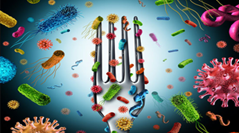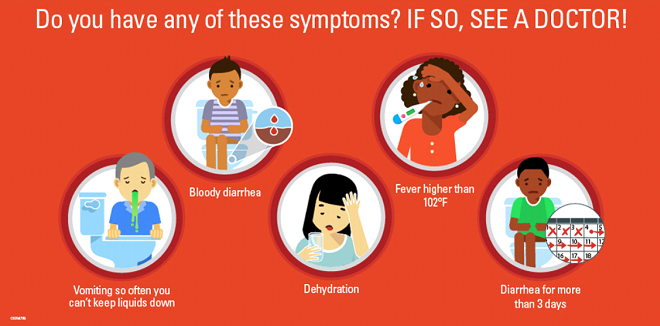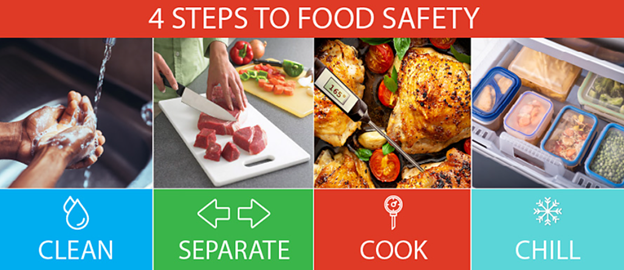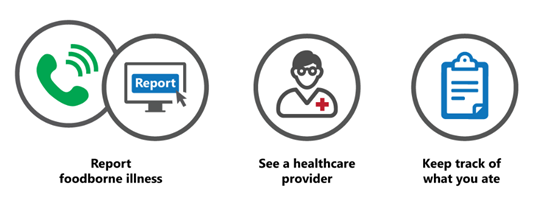Foodborne Illness and Outbreaks
Foodborne Illness and Outbreaks

Every year, 1 in 6 Americans are infected by a foodborne illness (FBI).1 Foodborne illness (also known as food poisoning or foodborne disease (FBD)) is a common preventable problem. Illness occurs when a person consumes contaminated food or beverages. Contamination can be due to bacteria, viruses, parasites or chemicals that can cause illness in humans. Onset of symptoms can vary depending on the pathogen. Symptoms range from being asymptomatic to severe requiring hospitalization or can even be fatal. The Centers for Disease Control and Prevention (CDC) estimate that 128,000 are hospitalized and there are at least 3,000 deaths that can be attributed to an FBI.1
Common Symptoms of Foodborne Illness
Commons symptoms can include nausea, vomiting, diarrhea, fever, and abdominal cramps.2
When to see a doctor?

Common Pathogens of Foodborne Illness
- Salmonella
- Campylobacter
- E. coli (STEC) 0157
- Giardiasis
- Cryptosporidiosis
- Vibriosis
- Listeriosis
- Shigellosis
- Hepatitis A
- Botulism
Additional causes for FBI can be found here: A-Z Index for Foodborne Illness, CDC
Common Contaminated Foods and Drinks3
- Raw or undercooked meat, poultry, and seafood(including beef, chicken, and oysters)
- Raw or unpasteurized milk, dairy products, and juice(including soft cheeses, ice cream, and apple cider)
- Raw or undercooked eggs
- Fresh fruits and vegetables(including sprouts, leafy greens, and unwashed produce)
- Raw flour(such as flour that is in raw cookie dough)
People at High Risk for Foodborne Illness4

Everyone is at risk for foodborne illness but certain groups can be at higher risk for more severe symptoms:
- Infants and children under 5.
- Older adults over 65.
- Pregnant women and their unborn babies.
- People with weakened immune systems.
- People traveling outside the U.S.
Foodborne Illness Prevention5

Clean: Wash your hands and surfaces often.
- Wash your hands for at least 20 seconds with soap and warm or cold water before, during, and after preparing food and before eating.
- Wash your utensils, cutting boards, and countertops with hot, soapy water after preparing each food item.
Separate: Don’t cross-contaminate.
- Raw meat, chicken and other poultry, seafood, and eggs can spread germs to ready-to-eat food unless you keep them separate. Keep raw or marinating meat, poultry, seafood, and eggs separate from all other foods in the refrigerator. Use separate cutting boards or plates for raw meat, poultry, and seafood and one for produce, bread, or other foods that won’t be cooked.
Cook to the right temperature.
- Food is safely cooked when the internal temperature gets high enough to kill germs that can make you sick.
- Whole cuts of beef, veal, lamb, and pork, including fresh ham: 145°F (then allow the meat to rest for 3 minutes before carving or eating)
- Fish with fins: 145°F or cook until the flesh is opaque and separates easily with a fork
- Ground meats, such as beef and pork: 160°F
- All poultry, including ground chicken and turkey: 165°F
- Leftovers and casseroles: 165°F
Chill: Refrigerate promptly.
- Bacteria can multiply rapidly if left at room temperature or in the “Danger Zone” between 40°F and 140°F.
Foodborne Outbreaks
An “outbreak” occurs when two or more people eat the same contaminated food. Outbreaks can occur when multiple people report similar illness after eating the same food but can also occur across multiple states when linked to a suppliers or distributor. If you suspect that you have been exposed to contaminated food, contact Northern Nevada Public Health, see a doctor or healthcare provider, and keep track of where and what you ate in the last week.

Report a Foodborne Illness or File a Complaint
To report a suspected foodborne illness or file a complaint about unsafe food handling practices at a restaurant, contact your Northern Nevada Public Health (NNPH).
2023 Outbreaks Affecting Washoe County Residents
Northern Nevada Public Health Foodborne Illness (FBI) Surveillance:
NNPH is currently building an FBI surveillance program where the goal is to control the exposure to and prevent foodborne illnesses.
- Conduct investigations and collect information to identify common exposures.
- Work hand-in-hand with internal and community partners to ensure food safety.
- Disseminate data trend reports and provide education and prevention to healthcare providers and the community.
Resources
- Centers for Disease Control and Prevention. Foodborne Germs and Illnesses. Accessed November 2023. https://www.cdc.gov/foodsafety/foodborne-germs.html.
- Centers for Disease Control and Prevention. Food Poisoning Symptoms. Access November 2023. https://www.cdc.gov/foodsafety/symptoms.html.
- Centers for Disease Control and Prevention. Foods that can Cause Food Poisoning. Accessed November 2023. https://www.cdc.gov/foodsafety/foods-linked-illness.html.
- Centers for Disease Control and Prevention. Factors that Increase your Risk for Food Poisoning. Accessed November 2023. https://www.cdc.gov/foodsafety/people-at-risk-food-poisoning.html.
- Centers for Disease Control and Prevention. Four Steps to Food Safety: Clean, Separate, Cook, and Chill. Accessed November 2023. https://www.cdc.gov/foodsafety/keep-food-safe.html.
Last modified on 12/14/2023
Let’s Stay in Touch
Sign up for our newsletter
